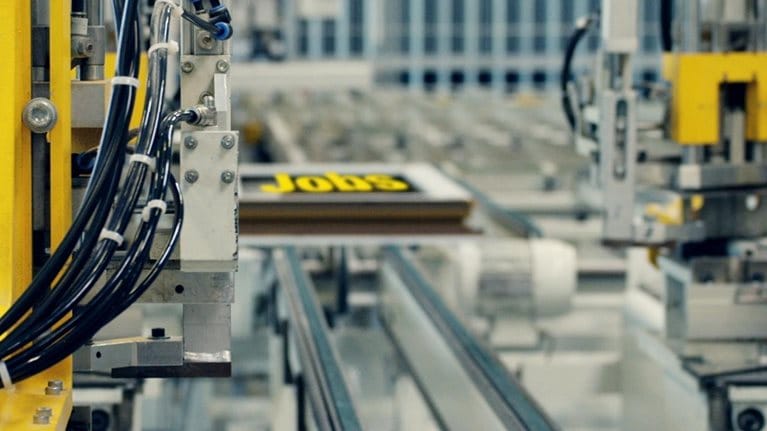Automation and artificial intelligence (AI) are transforming businesses and will contribute to economic growth via contributions to productivity. They will also help address “moonshot” societal challenges in areas from health to climate change.
Stay current on your favorite topics
At the same time, these technologies will transform the nature of work and the workplace itself. Machines will be able to carry out more of the tasks done by humans, complement the work that humans do, and even perform some tasks that go beyond what humans can do. As a result, some occupations will decline, others will grow, and many more will change.
While we believe there will be enough work to go around (barring extreme scenarios), society will need to grapple with significant workforce transitions and dislocation. Workers will need to acquire new skills and adapt to the increasingly capable machines alongside them in the workplace. They may have to move from declining occupations to growing and, in some cases, new occupations.
This executive briefing, which draws on the latest research from the McKinsey Global Institute, examines both the promise and the challenge of automation and AI in the workplace and outlines some of the critical issues that policy makers, companies, and individuals will need to solve for.
- Accelerating progress in AI and automation is creating opportunities for businesses, the economy, and society
- How AI and automation will affect work
- Key workforce transitions and challenges
- Ten things to solve for

Accelerating progress in AI and automation is creating opportunities for businesses, the economy, and society
Automation and AI are not new, but recent technological progress is pushing the frontier of what machines can do. Our research suggests that society needs these improvements to provide value for businesses, contribute to economic growth, and make once unimaginable progress on some of our most difficult societal challenges. In summary:
Rapid technological progress
Beyond traditional industrial automation and advanced robots, new generations of more capable autonomous systems are appearing in environments ranging from autonomous vehicles on roads to automated check-outs in grocery stores. Much of this progress has been driven by improvements in systems and components, including mechanics, sensors and software. AI has made especially large strides in recent years, as machine-learning algorithms have become more sophisticated and made use of huge increases in computing power and of the exponential growth in data available to train them. Spectacular breakthroughs are making headlines, many involving beyond-human capabilities in computer vision, natural language processing, and complex games such as Go.
Potential to transform businesses and contribute to economic growth
These technologies are already generating value in various products and services, and companies across sectors use them in an array of processes to personalize product recommendations, find anomalies in production, identify fraudulent transactions, and more. The latest generation of AI advances, including techniques that address classification, estimation, and clustering problems, promises significantly more value still. An analysis we conducted of several hundred AI use cases found that the most advanced deep learning techniques deploying artificial neural networks could account for as much as $3.5 trillion to $5.8 trillion in annual value, or 40 percent of the value created by all analytics techniques (Exhibit 1).

Deployment of AI and automation technologies can do much to lift the global economy and increase global prosperity, at a time when aging and falling birth rates are acting as a drag on growth. Labor productivity growth, a key driver of economic growth, has slowed in many economies, dropping to an average of 0.5 percent in 2010–2014 from 2.4 percent a decade earlier in the United States and major European economies, in the aftermath of the 2008 financial crisis after a previous productivity boom had waned. AI and automation have the potential to reverse that decline: productivity growth could potentially reach 2 percent annually over the next decade, with 60 percent of this increase from digital opportunities.
Potential to help tackle several societal moonshot challenges
AI is also being used in areas ranging from material science to medical research and climate science. Application of the technologies in these and other disciplines could help tackle societal moonshot challenges. For example, researchers at Geisinger have developed an algorithm that could reduce diagnostic times for intracranial hemorrhaging by up to 96 percent. Researchers at George Washington University, meanwhile, are using machine learning to more accurately weight the climate models used by the Intergovernmental Panel on Climate Change.
Challenges remain before these technologies can live up to their potential for the good of the economy and society everywhere
AI and automation still face challenges. The limitations are partly technical, such as the need for massive training data and difficulties “generalizing” algorithms across use cases. Recent innovations are just starting to address these issues. Other challenges are in the use of AI techniques. For example, explaining decisions made by machine learning algorithms is technically challenging, which particularly matters for use cases involving financial lending or legal applications. Potential bias in the training data and algorithms, as well as data privacy, malicious use, and security are all issues that must be addressed. Europe is leading with the new General Data Protection Regulation, which codifies more rights for users over data collection and usage.
A different sort of challenge concerns the ability of organizations to adopt these technologies, where people, data availability, technology, and process readiness often make it difficult. Adoption is already uneven across sectors and countries. The finance, automotive, and telecommunications sectors lead AI adoption. Among countries, US investment in AI ranked first at $15 billion to $23 billion in 2016, followed by Asia’s investments of $8 billion to $12 billion, with Europe lagging behind at $3 billion to $4 billion.

How AI and automation will affect work
Even as AI and automation bring benefits to business and society, we will need to prepare for major disruptions to work.
About half of the activities (not jobs) carried out by workers could be automated
Our analysis of more than 2000 work activities across more than 800 occupations shows that certain categories of activities are more easily automatable than others. They include physical activities in highly predictable and structured environments, as well as data collection and data processing. These account for roughly half of the activities that people do across all sectors. The least susceptible categories include managing others, providing expertise, and interfacing with stakeholders.
Nearly all occupations will be affected by automation, but only about 5 percent of occupations could be fully automated by currently demonstrated technologies. Many more occupations have portions of their constituent activities that are automatable: we find that about 30 percent of the activities in 60 percent of all occupations could be automated. This means that most workers—from welders to mortgage brokers to CEOs—will work alongside rapidly evolving machines. The nature of these occupations will likely change as a result.
Would you like to learn more about the McKinsey Global Institute?
Jobs lost: Some occupations will see significant declines by 2030
Automation will displace some workers. We have found that around 15 percent of the global workforce, or about 400 million workers, could be displaced by automation in the period 2016–2030. This reflects our midpoint scenario in projecting the pace and scope of adoption. Under the fastest scenario we have modeled, that figure rises to 30 percent, or 800 million workers. In our slowest adoption scenario, only about 10 million people would be displaced, close to zero percent of the global workforce (Exhibit 2).

The wide range underscores the multiple factors that will impact the pace and scope of AI and automation adoption. Technical feasibility of automation is only the first influencing factor. Other factors include the cost of deployment; labor-market dynamics, including labor-supply quantity, quality, and the associated wages; the benefits beyond labor substitution that contribute to business cases for adoption; and, finally, social norms and acceptance. Adoption will continue to vary significantly across countries and sectors because of differences in the above factors, especially labor-market dynamics: in advanced economies with relatively high wage levels, such as France, Japan, and the United States, automation could displace 20 to 25 percent of the workforce by 2030, in a midpoint adoption scenario, more than double the rate in India.
Jobs gained: In the same period, jobs will also be created
Even as workers are displaced, there will be growth in demand for work and consequently jobs. We developed scenarios for labor demand to 2030 from several catalysts of demand for work, including rising incomes, increased spending on healthcare, and continuing or stepped-up investment in infrastructure, energy, and technology development and deployment. These scenarios showed a range of additional labor demand of between 21 percent to 33 percent of the global workforce (555 million and 890 million jobs) to 2030, more than offsetting the numbers of jobs lost. Some of the largest gains will be in emerging economies such as India, where the working-age population is already growing rapidly.
Additional economic growth, including from business dynamism and rising productivity growth, will also continue to create jobs. Many other new occupations that we cannot currently imagine will also emerge and may account for as much as 10 percent of jobs created by 2030, if history is a guide. Moreover, technology itself has historically been a net job creator. For example, the introduction of the personal computer in the 1970s and 1980s created millions of jobs not just for semiconductor makers, but also for software and app developers of all types, customer-service representatives, and information analysts.
Jobs changed: More jobs than those lost or gained will be changed as machines complement human labor in the workplace
Partial automation will become more prevalent as machines complement human labor. For example, AI algorithms that can read diagnostic scans with a high degree of accuracy will help doctors diagnose patient cases and identify suitable treatment. In other fields, jobs with repetitive tasks could shift toward a model of managing and troubleshooting automated systems. At retailer Amazon, employees who previously lifted and stacked objects are becoming robot operators, monitoring the automated arms and resolving issues such as an interruption in the flow of objects.

Key workforce transitions and challenges
While we expect there will be enough work to ensure full employment in 2030 based on most of our scenarios, the transitions that will accompany automation and AI adoption will be significant. The mix of occupations will change, as will skill and educational requirements. Work will need to be redesigned to ensure that humans work alongside machines most effectively.
Workers will need different skills to thrive in the workplace of the future
Automation will accelerate the shift in required workforce skills we have seen over the past 15 years. Demand for advanced technological skills such as programming will grow rapidly. Social, emotional, and higher cognitive skills, such as creativity, critical thinking, and complex information processing, will also see growing demand. Basic digital skills demand has been increasing and that trend will continue and accelerate. Demand for physical and manual skills will decline but will remain the single largest category of workforce skills in 2030 in many countries (Exhibit 3). This will put additional pressure on the already existing workforce-skills challenge, as well as the need for new credentialing systems. While some innovative solutions are emerging, solutions that can match the scale of the challenge will be needed.

Many workers will likely need to change occupations
Our research suggests that, in a midpoint scenario, around 3 percent of the global workforce will need to change occupational categories by 2030, though scenarios range from about 0 to 14 percent. Some of these shifts will happen within companies and sectors, but many will occur across sectors and even geographies. Occupations made up of physical activities in highly structured environments or in data processing or collection will see declines. Growing occupations will include those with difficult to automate activities such as managers, and those in unpredictable physical environments such as plumbers. Other occupations that will see increasing demand for work include teachers, nursing aides, and tech and other professionals.
Workplaces and workflows will change as more people work alongside machines
As intelligent machines and software are integrated more deeply into the workplace, workflows and workspaces will continue to evolve to enable humans and machines to work together. As self-checkout machines are introduced in stores, for example, cashiers can become checkout assistance helpers, who can help answer questions or troubleshoot the machines. More system-level solutions will prompt rethinking of the entire workflow and workspace. Warehouse design may change significantly as some portions are designed to accommodate primarily robots and others to facilitate safe human-machine interaction.

Skill shift: Automation and the future of the workforce
Automation will likely put pressure on average wages in advanced economies
The occupational mix shifts will likely put pressure on wages. Many of the current middle-wage jobs in advanced economies are dominated by highly automatable activities, such as in manufacturing or in accounting, which are likely to decline. High-wage jobs will grow significantly, especially for high-skill medical and tech or other professionals, but a large portion of jobs expected to be created, including teachers and nursing aides, typically have lower wage structures. The risk is that automation could exacerbate wage polarization, income inequality, and the lack of income advancement that has characterized the past decade across advanced economies, stoking social, and political tensions.
In the face of these looming challenges, workforce challenges already exist
Most countries already face the challenge of adequately educating and training their workforces to meet the current requirements of employers. Across the OECD, spending on worker education and training has been declining over the last two decades. Spending on worker transition and dislocation assistance has also continued to shrink as a percentage of GDP. One lesson of the past decade is that while globalization may have benefited economic growth and people as consumers, the wage and dislocation effects on workers were not adequately addressed. Most analyses, including our own, suggest that the scale of these issues is likely to grow in the coming decades. We have also seen in the past that large-scale workforce transitions can have a lasting effect on wages; during the 19th century Industrial Revolution, wages in the United Kingdom remained stagnant for about half a century despite rising productivity—a phenomenon known as “Engels’ Pause,” (PDF–690KB) after the German philosopher who identified it.

Ten things to solve for
In the search for appropriate measures and policies to address these challenges, we should not seek to roll back or slow diffusion of the technologies. Companies and governments should harness automation and AI to benefit from the enhanced performance and productivity contributions as well as the societal benefits. These technologies will create the economic surpluses that will help societies manage workforce transitions. Rather, the focus should be on ways to ensure that the workforce transitions are as smooth as possible. This is likely to require actionable and scalable solutions in several key areas:
- Ensuring robust economic and productivity growth. Strong growth is not the magic answer for all the challenges posed by automation, but it is a prerequisite for job growth and increasing prosperity. Productivity growth is a key contributor to economic growth. Therefore, unlocking investment and demand, as well as embracing automation for its productivity contributions, is critical.
- Fostering business dynamism. Entrepreneurship and more rapid new business formation will not only boost productivity, but also drive job creation. A vibrant environment for small businesses as well as a competitive environment for large business fosters business dynamism and, with it, job growth. Accelerating the rate of new business formation and the growth and competitiveness of businesses, large and small, will require simpler and evolved regulations, tax and other incentives.
- Evolving education systems and learning for a changed workplace. Policy makers working with education providers (traditional and nontraditional) and employers themselves could do more to improve basic STEM skills through the school systems and improved on-the-job training. A new emphasis is needed on creativity, critical and systems thinking, and adaptive and life-long learning. There will need to be solutions at scale.
- Investing in human capital. Reversing the trend of low, and in some countries, declining public investment in worker training is critical. Through tax benefits and other incentives, policy makers can encourage companies to invest in human capital, including job creation, learning and capability building, and wage growth, similar to incentives for private sector to invest in other types of capital including R&D.
- Improving labor-market dynamism. Information signals that enable matching of workers to work, credentialing, could all work better in most economies. Digital platforms can also help match people with jobs and restore vibrancy to the labor market. When more people change jobs, even within a company, evidence suggests that wages rise. As more varieties of work and income-earning opportunities emerge including the gig economy, we will need to solve for issues such as portability of benefits, worker classification, and wage variability.
- Redesigning work. Workflow design and workspace design will need to adapt to a new era in which people work more closely with machines. This is both an opportunity and a challenge, in terms of creating a safe and productive environment. Organizations are changing too, as work becomes more collaborative and companies seek to become increasingly agile and nonhierarchical.
- Rethinking incomes. If automation (full or partial) does result in a significant reduction in employment and/or greater pressure on wages, some ideas such as conditional transfers, support for mobility, universal basic income, and adapted social safety nets could be considered and tested. The key will be to find solutions that are economically viable and incorporate the multiple roles that work plays for workers, including providing not only income, but also meaning, purpose, and dignity.
- Rethinking transition support and safety nets for workers affected. As work evolves at higher rates of change between sectors, locations, activities, and skill requirements, many workers will need assistance adjusting. Many best practice approaches to transition safety nets are available, and should be adopted and adapted, while new approaches should be considered and tested.
- Investing in drivers of demand for work. Governments will need to consider stepping up investments that are beneficial in their own right and will also contribute to demand for work (for example, infrastructure, climate-change adaptation). These types of jobs, from construction to rewiring buildings and installing solar panels, are often middle-wage jobs, those most affected by automation.
- Embracing AI and automation safely. Even as we capture the productivity benefits of these rapidly evolving technologies, we need to actively guard against the risks and mitigate any dangers. The use of data must always take into account concerns including data security, privacy, malicious use, and potential issues of bias, issues that policy makers, tech and other firms, and individuals will need to find effective ways to address.
There is work for everyone today and there will be work for everyone tomorrow, even in a future with automation. Yet that work will be different, requiring new skills, and a far greater adaptability of the workforce than we have seen. Training and retraining both midcareer workers and new generations for the coming challenges will be an imperative. Government, private-sector leaders, and innovators all need to work together to better coordinate public and private initiatives, including creating the right incentives to invest more in human capital. The future with automation and AI will be challenging, but a much richer one if we harness the technologies with aplomb—and mitigate the negative effects.


